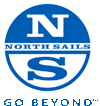 North 420 Tuning Guide
North 420 Tuning Guide 
 North 420 Tuning Guide
North 420 Tuning Guide 
Mast StepMeasured from the inside of transom to the back of the mast 2830 mm. SpreadersLength is measured from the side wall of the mast to the shroud. To measure spreader deflection we place the top batten (or any straight edge) across the tips of the spreaders and then measure to the mast off the straight edge.
Mast RakeMeasured by attaching a long tape measure to the top of the main halyard ,hoisting it to the top of the mast & then measuring to the back of the transom with the rig tension on & NO CHOCKS inserted.
Rig TensionWe measure rig tension off the shrouds at shoulder height with a Superspar or Loo's tension meter. The first number in the table below is for the Superspar, with the 2nd figure being for the Loo's meter.
NB - If caught out on the wrong mast rake you my want to either ease or add tension accordingly to achieve the best set up. ChocksControl the amount of pre-bend in the mast. This is crucial for controlling the amount of power in the rig. You should have 3x15mm chocks, which are easily accessible, as chocking the mast is the only adjustment you can make to the mast whilst racing.
CentreboardThis should be angled forwards in light airs. When planing upwind the leading edge of centreboard should be vertical, as the wind increases the centreboard can be raked aft (no more than 6 inches of centreboard handle showing out of the case). Sail Setting and AdjustmentMainsailTop BattenIn light airs the top batten should be pushed in lightly and the Velcro fastened just to prevent batten from falling out. In medium/heavy airs, push the batten in quite hard and secure Velcro. CunninghamUse only when overpowered to move draft of sail forwards and open the upper leech. Never use in light airs to remove the horizontal creases from the luff . Kicking StrapNo tension is needed until mainsail has to be eased to prevent heeling. Use kicker to hold correct leech profile. when overpowered, pull on as hard as physically possible. NB- Ensure that you have the maximum purchase allowed by the class rules OuthaulGenerally pull very tight in all conditions, except in a light air chop when the outhaul can be eased approximately 25mm. Mainsail Leech TensionThis is determined by leech tell tale behaviour. Generally the top tell tale should be flying 90% of the time. JibWhilst on shore it is a good idea to mark both jib sheeting and barberhaulers. Tie the boat down to the trolley and place on a beat. Sheet in both mainsail and jib from behind and look at the slot (gap between mainsail and jib). Because the 420 has fixed sheeting angles, the slot is not as efficient as it could be. You are looking to get the slot parallel all the way up between the mainsail luff & the jib leech. Make sure the jib is in tight, then ease it one inch and pull the windward jib sheet (barberhauler) on quite hard and cleat it. Doing this pulls the clew inboard about 3 - 4 inches and creates a more efficient slot shape. Now with a waterproof pen, mark both jib sheets and barberhaulers so you can refer to these settings whilst afloat. This method of barberhauling should be used in all conditions except:
Jib CunninghamThis should be tightened enough to remove creases from luff of the sail. It acts the same as the cunningham on the mainsail Basic 420 Rules
|
Eine Service-Seite von NORTH SAILS ONE DESIGN
Copyright © 2009 North Sails UK Ltd.
Tel: 02392 354800
Revised: